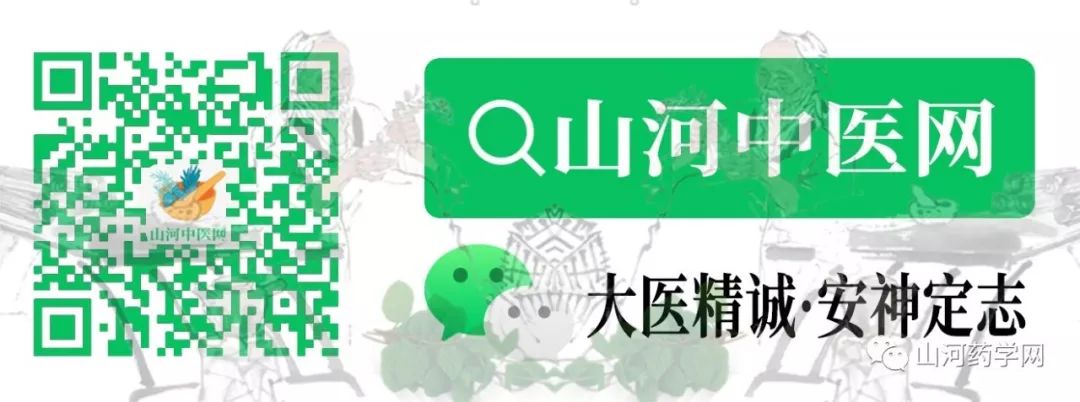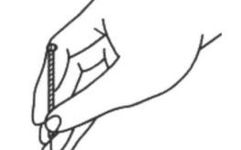Acupuncture Techniques – Discussion on Needle Insertion Techniques (Part 1)
6. Needle Manipulation Techniques After the fine needle is inserted into the acupoint, the operational methods used to elicit the sensation of acupuncture in the patient, adjust the intensity of the sensation, and direct the sensation in a specific direction are referred to as “needle manipulation” or “needle movement.” The techniques of needle manipulation are generally divided into two main categories: basic techniques and auxiliary techniques. 1. Basic Techniques The basic techniques of needle manipulation are fundamental skills in fine needle acupuncture, commonly including the lifting and thrusting method and the twisting method. (1) Lifting and Thrusting Method: After the needle is inserted into the acupoint, this method involves moving the needle up and down within the acupoint, as shown in Figure 5-10. Lifting: The needle is withdrawn from a deeper layer to a shallower layer. Thrusting: The needle is inserted from a shallower layer to a deeper layer. The amplitude of lifting and thrusting, the changes in depth, the speed of manipulation, and the duration of operation should be flexibly adjusted based on the patient’s constitution, condition, acupoint location, and the purpose of acupuncture. When using the lifting and thrusting method, the force applied by the fingers should be uniform, and the amplitude should not be excessive, generally maintained at 3-5 minutes, with a frequency not exceeding 60 times per minute, keeping the needle body vertical without changing the angle or direction of insertion. A larger amplitude, faster frequency, and longer duration will increase the stimulation; conversely, a smaller amplitude, slower frequency, and shorter duration will decrease the stimulation.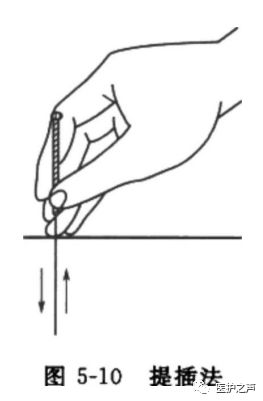
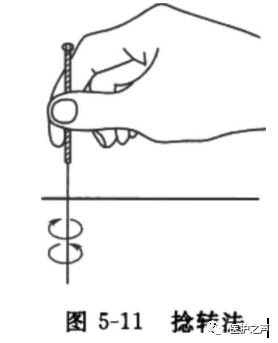 (2) Twisting Method: After the needle is inserted to a certain depth in the acupoint, the right thumb and the middle and index fingers hold the needle handle to perform a back-and-forth twisting motion, as shown in Figure 5-11. The angle of twisting, the speed of manipulation, and the duration should be determined based on the specific conditions of the patient’s constitution, condition, acupoint location, and the purpose of acupuncture. When using the twisting method, the force applied by the fingers should be uniform, and the angle should be appropriate, generally around 180 degrees. Twisting in one direction only should be avoided, as it may cause the needle body to become entangled with muscle fibers, leading to pain during acupuncture and difficulty in needle removal. It is generally believed that a larger twisting angle, faster frequency, and longer duration will increase the stimulation; conversely, a smaller twisting angle, slower frequency, and shorter duration will decrease the stimulation. Both of these basic methods can be used independently or in combination, and in clinical practice, they must be flexibly adjusted according to the specific situation of the patient to achieve their intended effects. 2. Auxiliary Techniques Auxiliary techniques are operational methods used to assist in needle manipulation during acupuncture, commonly including six types, as shown in Table 5-9 and Figure 5-12. The fine needle manipulation techniques primarily utilize lifting and thrusting, and twisting as basic operational methods, supplemented by appropriate auxiliary techniques based on clinical conditions.
(2) Twisting Method: After the needle is inserted to a certain depth in the acupoint, the right thumb and the middle and index fingers hold the needle handle to perform a back-and-forth twisting motion, as shown in Figure 5-11. The angle of twisting, the speed of manipulation, and the duration should be determined based on the specific conditions of the patient’s constitution, condition, acupoint location, and the purpose of acupuncture. When using the twisting method, the force applied by the fingers should be uniform, and the angle should be appropriate, generally around 180 degrees. Twisting in one direction only should be avoided, as it may cause the needle body to become entangled with muscle fibers, leading to pain during acupuncture and difficulty in needle removal. It is generally believed that a larger twisting angle, faster frequency, and longer duration will increase the stimulation; conversely, a smaller twisting angle, slower frequency, and shorter duration will decrease the stimulation. Both of these basic methods can be used independently or in combination, and in clinical practice, they must be flexibly adjusted according to the specific situation of the patient to achieve their intended effects. 2. Auxiliary Techniques Auxiliary techniques are operational methods used to assist in needle manipulation during acupuncture, commonly including six types, as shown in Table 5-9 and Figure 5-12. The fine needle manipulation techniques primarily utilize lifting and thrusting, and twisting as basic operational methods, supplemented by appropriate auxiliary techniques based on clinical conditions. Table 5-9 Auxiliary Techniques
Table 5-9 Auxiliary Techniques
|
Name |
Operational Points |
Function |
Source |
|
Circular Method
|
It involves gently pressing along the pathway of the meridian above and below the acupoint with the fingers. |
Promotes Qi, stimulates blood flow, activates meridian Qi, and facilitates the sensation of acupuncture. |
As stated in “The Great Compendium of Acupuncture and Moxibustion”: “When inserting the needle, if Qi does not arrive, use your fingers along the pathway of the corresponding meridian, pressing up and down to ensure Qi and blood circulate evenly, allowing Qi to arrive naturally at the needle site.” |
|
Flicking Method
|
After needle insertion, during the retention of the needle, lightly flick the needle tail or handle with the fingers to create gentle vibrations in the needle body. |
Stimulates Qi, promotes Qi flow, and enhances the sensation of acupuncture. |
As mentioned in “Questions and Answers on Acupuncture”: “If Qi does not flow, lightly flick the needle to promote its rapid movement.” |
|
Scraping Method
|
After the fine needle is inserted to a certain depth, if Qi has not arrived, use the thumb or index finger to press against the needle tail, and scrape the needle handle up and down with the thumb, index, or middle finger nails. |
Used to disperse meridian Qi when Qi has not arrived; if Qi has already arrived, it can enhance the conduction and diffusion of the acupuncture sensation. |
|
|
Shaking Method
|
After the fine needle is inserted to a certain depth, hold the needle handle and gently shake the needle. |
There are two methods: one is to keep the needle upright while shaking to enhance the sensation of Qi; the other is to lay the needle down while shaking to direct the meridian Qi in a specific direction. |
As recorded in “Questions and Answers on Acupuncture”: “There is a record of ‘shaking to promote Qi.'” |
|
Flying Method |
When Qi has not arrived after needle insertion, hold the needle handle with the right thumb and index finger, twist and rub it several times, then open the fingers, alternating between twisting and releasing repeatedly, resembling a bird spreading its wings. |
Stimulates Qi, promotes Qi flow, and enhances the sensation of acupuncture. |
As stated in “Introduction to Medicine”: “Using the thumb and index finger to twist the needle three times, resembling a trembling hand, is called flying.” |
|
Trembling Method |
After the needle is inserted to a certain depth in the acupoint, hold the needle handle with the right hand and use small amplitude, high frequency lifting and thrusting or twisting techniques to create slight vibrations in the needle body. |
Facilitates the arrival of Qi under the needle and enhances the sensation of acupuncture. |

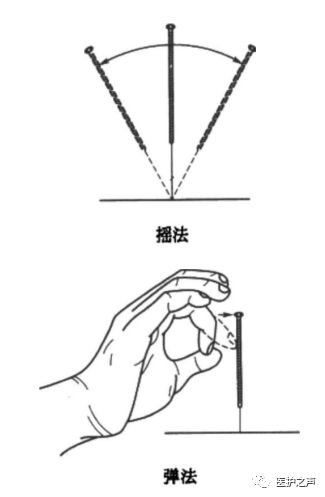
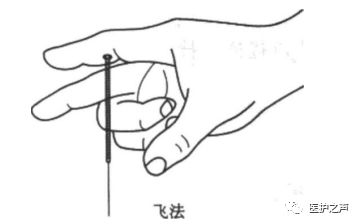 Figure 5-12 Auxiliary Techniques for Fine Needle Manipulation 7. Arrival of Qi, Waiting for Qi, Promoting Qi, and Guarding Qi 1. Arrival of Qi The arrival of Qi, historically referred to as “Qi arriving,” is now also known as “needle sensation.” It refers to the sensation experienced at the acupoint after the fine needle is inserted to a certain depth, followed by the application of twisting or lifting and thrusting techniques to elicit a response of meridian Qi at the needle site. (1) The manifestations of the arrival of Qi are shown in Table 5-10.Table 5-10 Differences in Sensation Between Patients and Practitioners When Qi Arrives or Does Not Arrive
Figure 5-12 Auxiliary Techniques for Fine Needle Manipulation 7. Arrival of Qi, Waiting for Qi, Promoting Qi, and Guarding Qi 1. Arrival of Qi The arrival of Qi, historically referred to as “Qi arriving,” is now also known as “needle sensation.” It refers to the sensation experienced at the acupoint after the fine needle is inserted to a certain depth, followed by the application of twisting or lifting and thrusting techniques to elicit a response of meridian Qi at the needle site. (1) The manifestations of the arrival of Qi are shown in Table 5-10.Table 5-10 Differences in Sensation Between Patients and Practitioners When Qi Arrives or Does Not Arrive
|
Subject |
Arrival of Qi |
No Arrival of Qi |
|
Patient’s Sensation
|
Experiences corresponding sensations such as fullness, numbness, heaviness, or pressure at the needle site, which may radiate along specific pathways. |
No sensations of fullness, numbness, heaviness, or pressure.
|
|
Practitioner’s Sensation |
Feels a sensation of heaviness and/or tightness under the needle. |
Feels emptiness under the needle. |
As described by Dou Hanqing in “The Mark of the Ghost”: “Light and smooth but not yet arrived, heavy and tight and already arrived… The arrival of Qi is like a fish swallowing a hook, floating and sinking; when Qi has not arrived, it is like a deep and secluded hall.” This is a vivid description of whether Qi has arrived or not.
(2) Significance of Qi Arrival: The arrival of Qi is closely related to the efficacy of acupuncture. As stated in “The Spiritual Pivot: Nine Needles and Twelve Origins”: “The key to acupuncture is the arrival of Qi for effectiveness.” In “The Mark of the Ghost,” it is said: “Qi arrives quickly, and efficacy is quick; Qi arrives slowly, and efficacy is slow.” This indicates that acupuncture must achieve Qi arrival, as it directly affects the treatment outcome. Generally speaking, rapid Qi arrival leads to better efficacy; slow Qi arrival leads to poorer efficacy; if Qi does not arrive, there is no therapeutic effect.
(3) Factors Affecting Qi Arrival: Inaccurate acupoint location; incorrect needle insertion angle; inappropriate depth.
2. Waiting for Qi
“The Great Compendium of Acupuncture and Moxibustion” states: “In the method of using needles, waiting for Qi is paramount.” When Qi has not arrived under the needle, it is necessary to adopt the method of retaining the needle and waiting for Qi to arrive. Intermittent needle manipulation techniques such as lifting, thrusting, and twisting can also be applied to await the arrival of Qi. Patience is required when waiting for Qi; one should not be overly anxious.
3. Promoting Qi
Promoting Qi refers to the various techniques used to encourage the rapid arrival of meridian Qi. “The Divine Response Classic” states: “Using the right thumb and index finger to hold the needle, gently shake, move in and out, and twist, resembling a trembling hand, is called promoting Qi.” Additionally, the auxiliary techniques discussed earlier, such as scraping the needle handle, flicking the needle handle, and following the meridian pathway, also serve to promote Qi.
4. Guarding Qi
The arrival of Qi is the key to achieving therapeutic effects in clinical practice. Once Qi has arrived, it must be carefully guarded. Practitioners should adopt methods to maintain the Qi under the needle to ensure the sensation lasts. As stated in “The Plain Questions: Discussion on the Complete Form of Life”: “Once the meridian Qi has arrived, be cautious to guard it and not lose it.” In “The Spiritual Pivot: Explanation of Small Needles,” it is said: “Those who guard Qi well know how to maintain it… Once Qi is obtained, it is essential to guard it well; only by guarding the Qi under the needle can the acupuncture continue to exert its regulatory effects on the body.
8. Supplementing and Draining Techniques for Fine Needles
1. Single Supplementing and Draining Techniques
The summary of single supplementing and draining techniques is shown in Table 5-11.
Table 5-11 Summary of Single Supplementing and Draining Techniques
|
Name |
Supplementing Method |
Draining Method |
|
Twisting Supplementing and Draining
|
Small twisting angle, light force, slow frequency, short duration, thumb forward, index finger backward. |
Large twisting angle, heavy force, fast frequency, long duration, thumb backward, index finger forward. |
|
Lifting and Thrusting Supplementing and Draining
|
Shallow first, then deep, heavy thrusting, light lifting, small amplitude, slow frequency, short duration, primarily thrusting. |
Deep first, then shallow, light thrusting, heavy lifting, large amplitude, fast frequency, long duration, primarily lifting. |
|
Fast and Slow Supplementing and Draining |
Slow insertion, fast withdrawal. |
Fast insertion, slow withdrawal. |
|
Following and Leading Supplementing and Draining |
The needle tip follows the direction of the meridian. |
The needle tip goes against the direction of the meridian. |
|
Breathing Supplementing and Draining |
Insert the needle during exhalation, withdraw during inhalation. |
Withdraw during exhalation, insert during inhalation. |
|
Opening and Closing Supplementing and Draining |
After needle withdrawal, press to close the needle hole. |
Do not press to close the needle hole during withdrawal, or enlarge the needle hole. |
|
Even Supplementing and Draining |
After obtaining Qi, perform even lifting, thrusting, and twisting. |
2. Compound Supplementing and Draining Techniques
The summary of compound supplementing and draining techniques is shown in Table 5-12.
Table 5-12 Summary of Compound Supplementing and Draining Techniques
|
Name |
Operational Points |
Indications |
|
Burning Mountain Fire
|
Insert the needle into the upper third (heavenly part) of the required depth, perform twisting supplementing after obtaining Qi, then insert into the middle third (human part), perform twisting supplementing after obtaining Qi, and finally insert into the lower third (earth part), perform twisting supplementing after obtaining Qi. Repeat this operation three times, then press the needle firmly to the earth part and retain it. During the operation, the breathing supplementing method can be combined with the supplementing method. |
Commonly used to treat cold bi syndrome, stubborn numbness, and direct cold diseases. |
|
透天凉 (Tòu Tiān Liáng)
|
Insert the needle into the lower third (earth part) of the required depth, perform twisting draining after obtaining Qi, then lift the needle to the middle third (human part), perform twisting draining after obtaining Qi, and finally lift the needle to the upper third (heavenly part), perform twisting draining after obtaining Qi, and then slowly press down to the lower third. Repeat this operation three times, and then lift the needle to the upper third for retention. During the operation, the draining method from the breathing supplementing method can be combined. |
Commonly used to treat heat bi syndrome, acute pain and swelling, and other excess heat diseases.
|
9. Factors Affecting the Effects of Supplementing and Draining in Acupuncture 1. The Functional State of the Body This is the primary factor influencing the effects of supplementing and draining in acupuncture. The body can produce different effects under various pathological states, leading to different outcomes of supplementing or draining. For example, when the body is in a state of deficiency, acupuncture can have a supplementing effect; when the body is in a state of excess, characterized by heat, blockage, or fullness, acupuncture can drain excess and clear heat. For instance, in cases of gastrointestinal spasms and pain, acupuncture can relieve spasms and alleviate pain; when gastrointestinal motility is slow, acupuncture can enhance motility and restore normal function. 2. The Relative Specificity of Acupoint Functions The therapeutic functions of acupoints not only have universality but also relative specificity. Some acupoints are suitable for supplementing deficiency, while others are suitable for draining excess. For example, acupoints such as Guanyuan (CV4), Qihai (CV6), Mingmen (GV4), and Gaohuang (BL43) can invigorate the body’s vital energy, promote vigorous function, and have a strengthening effect, making them suitable for supplementing deficiency and benefiting the body; while acupoints such as Shuigou (CV3), Weizhong (BL40), Shierjing (TW1), and Shixuan (PC8) can disperse pathogenic factors, inhibit excessive bodily functions, and have a draining effect, making them suitable for expelling pathogens and draining excess. 3. Factors Related to the Needle and Technique The effects of supplementing and draining in acupuncture are directly related to the thickness and length of the needles used, the angle and depth of insertion, and the techniques employed during needle manipulation.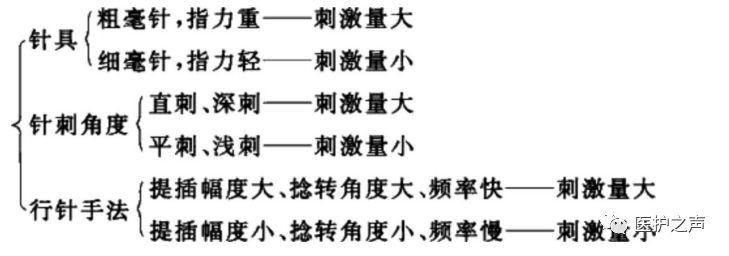 10. Needle Retention and Withdrawal1. Needle Retention Method The method of leaving the needle in the acupoint after insertion and manipulation is called needle retention.Purpose of Needle Retention: To enhance the effects of acupuncture and facilitate continued manipulation.Operational Points: Generally, for common conditions, once Qi has arrived under the needle and appropriate supplementing and draining techniques have been applied, the needle can be retained for 10-20 minutes. For chronic, stubborn, painful, or spasmodic diseases, the retention time can be appropriately extended; for acute abdominal pain, trigeminal neuralgia, dysmenorrhea, etc., the retention time can reach several hours, allowing for intermittent manipulation during retention to enhance and consolidate the therapeutic effect.Precautions: In clinical practice, whether to retain the needle and the duration of retention should not be generalized but should be determined based on the specific condition of the patient. 2. Needle Withdrawal Method The method of withdrawing the needle after completing the manipulation is referred to as needle withdrawal, also known as needle removal or needle extraction. After achieving the intended acupuncture goals and therapeutic requirements, the needle can be withdrawn.Operational Points: Generally, use the left thumb and index finger to hold a disinfected cotton ball gently against the needle insertion site, while the right hand gently twists the needle and slowly withdraws it just beneath the skin (do not use excessive force with one hand). Wait a moment, then withdraw the needle. During withdrawal, depending on the requirements of supplementing or draining, either a “fast withdrawal” or “slow withdrawal” method, as well as “fast pressing on the needle hole” or “shaking the needle hole larger” methods, should be employed.Precautions: After needle withdrawal, unless there are special needs, a disinfected cotton ball should be pressed against the needle hole for a moment to prevent bleeding or pain at the needle site. After withdrawal, carefully check the needle hole for bleeding, inquire about any discomfort at the needle site, verify the number of needles used to ensure none are missing, and be alert for any delayed reactions to the needle.11. Handling and Prevention of Abnormal Situations Although acupuncture is generally safe, improper operation, negligence, or violations of contraindications, or improper techniques, or lack of comprehensive understanding of human anatomy can sometimes lead to unexpected abnormal situations. The most common include the following:1. Needle Shock
10. Needle Retention and Withdrawal1. Needle Retention Method The method of leaving the needle in the acupoint after insertion and manipulation is called needle retention.Purpose of Needle Retention: To enhance the effects of acupuncture and facilitate continued manipulation.Operational Points: Generally, for common conditions, once Qi has arrived under the needle and appropriate supplementing and draining techniques have been applied, the needle can be retained for 10-20 minutes. For chronic, stubborn, painful, or spasmodic diseases, the retention time can be appropriately extended; for acute abdominal pain, trigeminal neuralgia, dysmenorrhea, etc., the retention time can reach several hours, allowing for intermittent manipulation during retention to enhance and consolidate the therapeutic effect.Precautions: In clinical practice, whether to retain the needle and the duration of retention should not be generalized but should be determined based on the specific condition of the patient. 2. Needle Withdrawal Method The method of withdrawing the needle after completing the manipulation is referred to as needle withdrawal, also known as needle removal or needle extraction. After achieving the intended acupuncture goals and therapeutic requirements, the needle can be withdrawn.Operational Points: Generally, use the left thumb and index finger to hold a disinfected cotton ball gently against the needle insertion site, while the right hand gently twists the needle and slowly withdraws it just beneath the skin (do not use excessive force with one hand). Wait a moment, then withdraw the needle. During withdrawal, depending on the requirements of supplementing or draining, either a “fast withdrawal” or “slow withdrawal” method, as well as “fast pressing on the needle hole” or “shaking the needle hole larger” methods, should be employed.Precautions: After needle withdrawal, unless there are special needs, a disinfected cotton ball should be pressed against the needle hole for a moment to prevent bleeding or pain at the needle site. After withdrawal, carefully check the needle hole for bleeding, inquire about any discomfort at the needle site, verify the number of needles used to ensure none are missing, and be alert for any delayed reactions to the needle.11. Handling and Prevention of Abnormal Situations Although acupuncture is generally safe, improper operation, negligence, or violations of contraindications, or improper techniques, or lack of comprehensive understanding of human anatomy can sometimes lead to unexpected abnormal situations. The most common include the following:1. Needle Shock
|
Definition |
Fainting that occurs during acupuncture. |
|
|
Causes |
Patient Factors |
Due to mental tension, physical weakness, excessive fatigue, hunger, or after excessive sweating, diarrhea, or blood loss. |
|
Practitioner Factors |
Improper positioning or excessive force during the procedure. |
|
|
Symptoms |
Light cases may present with dizziness, pale complexion, palpitations, shortness of breath, cold sweat, nausea, fatigue, and a weak pulse. |
|
|
Severe cases may present with cold limbs, low blood pressure, loss of consciousness, incontinence, cyanosis of lips and nails, and a faint pulse. |
||
|
Management |
Immediately stop acupuncture, withdraw all needles, and have the patient lie flat, ensuring warmth. |
|
|
Light Cases |
Rest for a moment, provide warm water or sugar water, and the patient should recover normally. |
|
|
Severe Cases |
After the above management, acupuncture points such as Renzhong (GV26), Suli (PC8), Neiguan (PC6), and Zusanli (ST36) can be stimulated, as well as moxibustion at Baihui (GV20), Qihai (CV6), and Guanyuan (CV4) to restore consciousness. If the patient remains unresponsive, with weak breathing and pulse, consider additional treatments or emergency measures. |
|
|
Patient Factors |
For patients receiving acupuncture for the first time or those who are mentally tense or physically weak, proper explanations should be provided to alleviate concerns about acupuncture. Choose a comfortable and sustained position, preferably lying down, select fewer acupoints, and apply gentle techniques. If the patient is hungry, fatigued, or very thirsty, allow them to eat, rest, and hydrate before acupuncture. |
|
|
Practitioner Factors |
During acupuncture treatment, maintain focus, observe the patient’s complexion, and inquire about their sensations. If any discomfort or signs of needle shock occur, take early preventive measures. |
2. Stuck Needle
|
Definition |
A sensation of resistance during needle manipulation or retention, making twisting, lifting, or withdrawal difficult, accompanied by pain for the patient. |
|
|
Causes |
Patient Factors |
Mental tension causing strong muscle contraction at the acupoint after needle insertion. |
|
Practitioner Factors |
Improper needle manipulation techniques, excessive twisting in one direction, causing muscle fibers to entangle with the needle body. Prolonged retention time may also lead to stuck needles. |
|
|
Symptoms |
The needle feels stuck in the body, making twisting, lifting, or withdrawal difficult. Forcing these actions may cause unbearable pain for the patient. |
|
|
Management |
Address the underlying cause. |
|
|
Patient Factors |
If the patient is tense and muscles are overly contracted, extend the retention time slightly, or apply gentle pressing or flicking near the stuck needle site, or insert another needle nearby to disperse Qi and blood, relieving muscle tension. |
|
|
Practitioner Factors |
If improper manipulation or excessive twisting has caused the stuck needle, gently twist the needle back in the opposite direction and use scraping or flicking techniques to release the entangled muscle fibers, thus eliminating the stuck needle. |
|
|
Prevention |
For patients who are tense, provide proper explanations to alleviate their concerns, pay attention to needle manipulation techniques, and avoid excessive twisting in one direction. When using the rubbing method, ensure it is coordinated with the lifting and thrusting method to prevent muscle fibers from entangling with the needle body and causing stuck needles. |
3. Bent Needle
|
Definition |
A phenomenon where the needle bends inside the body during insertion or after being inserted into the acupoint. |
|
Causes |
Practitioner factors include unskilled insertion techniques, excessive force or speed causing the needle to hit hard tissue, or inappropriate patient positioning. Changing the position during needle retention can also lead to bending due to external pressure on the needle handle. |
|
Symptoms |
The needle handle changes direction or angle during insertion or retention, making twisting, lifting, and withdrawal difficult, accompanied by pain for the patient. |
|
Management |
Once a bent needle is detected, do not perform twisting, lifting, or other manipulations. Avoid forcibly withdrawing the needle to prevent breaking it and leaving it inside the body. |
|
Withdrawal Method |
If the bending is slight, slowly withdraw the needle; if the bending is significant, withdraw it in the direction of the bend. If the bending is due to patient position changes, allow the patient to slowly return to the original position and relax the local muscles before gently withdrawing the needle. |
|
Prevention |
Practitioners should be skilled in techniques, apply gentle force, and avoid excessive speed during insertion. Ensure the patient is comfortable, and avoid changing positions during needle retention. The insertion site and needle handle should not be subjected to external pressure or impact. |
4. Broken Needle
|
Definition |
Also known as a fractured needle, it refers to the needle body breaking inside the human body. |
|
Causes |
Poor quality of needles, or damage to the needle body or root, or failure to check before the procedure. During needle insertion, if the needle is fully inserted and excessive force is applied during manipulation, strong muscle contractions may occur. Changing the patient’s position during needle retention, or failing to address bent or stuck needles promptly and forcefully withdrawing them, or external pressure can also lead to breakage. |
|
Symptoms |
During manipulation or after withdrawal, the needle body may be found to be broken, with part of the needle still exposed above the skin, or the broken end completely submerged beneath the skin. The practitioner must remain calm and composed, instructing the patient not to move to prevent the broken needle from sinking deeper into the muscle. |
|
Withdrawal Method |
If the broken end is exposed, use fingers or tweezers to remove it. If the broken end is level with or slightly recessed beneath the skin, apply pressure on both sides of the needle hole with the left thumb and index finger to expose the broken needle, then use tweezers to extract it. If the broken needle is completely submerged beneath the skin or deep within the muscle, locate it under X-ray guidance and surgically remove it. |
|
Prevention |
To prevent needle breakage, carefully inspect the needles, and avoid using those that do not meet quality standards. Avoid excessive force during manipulation; during insertion or retention, instruct the patient not to change positions. When inserting the needle, do not fully insert it into the acupoint; leave part of the needle exposed to facilitate removal in case of breakage. If bending is detected during insertion, withdraw the needle immediately; do not force it in or manipulate it. Timely and correct handling of stuck needles is also essential to prevent breakage. |
5. Hematoma:
|
Definition |
Refers to subcutaneous bleeding at the needle insertion site, causing swelling and pain. |
|
Causes |
The needle tip may be bent or hooked, damaging the skin or injuring blood vessels. |
|
Symptoms |
After needle withdrawal, the insertion site may swell and hurt, followed by the skin turning purple. |
|
Management |
If there is minor subcutaneous bleeding with small localized bruising, generally no treatment is needed, as it will resolve on its own. If there is significant swelling and pain, apply cold compresses to stop bleeding, then apply heat and gently massage the area to promote the absorption of the bruise. Prevention includes careful inspection of needles, familiarization with human anatomy, and avoiding blood vessels during needle insertion. Immediately apply pressure with a disinfected cotton ball at the needle hole after withdrawal to prevent bleeding. |
12. Precautions for Acupuncture Due to factors such as physiological states and living conditions, the following aspects should also be considered during acupuncture treatment.
|
Constitution |
Patients who are overly hungry, fatigued, or excessively tense should not undergo acupuncture immediately. For patients who are thin, Qi-deficient, or blood-deficient, the techniques should not be too forceful, and a lying position should be preferred. Pregnant women in their first three months should avoid acupuncture at the lower abdomen. |
|
Women |
Women who are more than three months pregnant should avoid acupuncture at the abdomen and lower back, as well as acupoints such as Sanyinjiao (SP6), Hegu (LI4), Kunlun (BL60), and Zhiyin (BL67), which promote circulation and blood flow. During pregnancy, acupuncture should also be avoided during menstruation unless it is for menstrual regulation. |
|
Children |
Acupoints on the top of the head should not be needled before the fontanelle has closed. |
|
Condition |
Patients with spontaneous bleeding or persistent bleeding after injury should not be needled at sites with skin infections, ulcers, scars, or swelling. For patients with urinary retention, the direction, angle, and depth of needle insertion at the lower abdomen should be carefully controlled to avoid injuring the bladder or other organs. |
|
Special Acupoints |
Acupoints located over the chest, ribs, waist, and back should not be needled deeply or directly. Special caution should be taken with patients who have liver or spleen enlargement or emphysema, particularly regarding acupoints around the eyes and neck, as well as spinal acupoints. Careful attention should be paid to the angle of insertion, and excessive lifting, thrusting, and prolonged retention should be avoided to prevent injury to vital organs and serious adverse consequences. |
Disclaimer:The content of this site is added and organized by users and is for learning and reference purposes only. The information on this site may not be accurate, comprehensive, or up-to-date, and the content should not be considered the final basis for diagnosing or treating diseases.Shanhe Traditional Chinese Medicine Network reminds users that if there are any physical discomforts, please seek medical attention promptly. Thank you for your support and love; we will strive to do better~!!!
